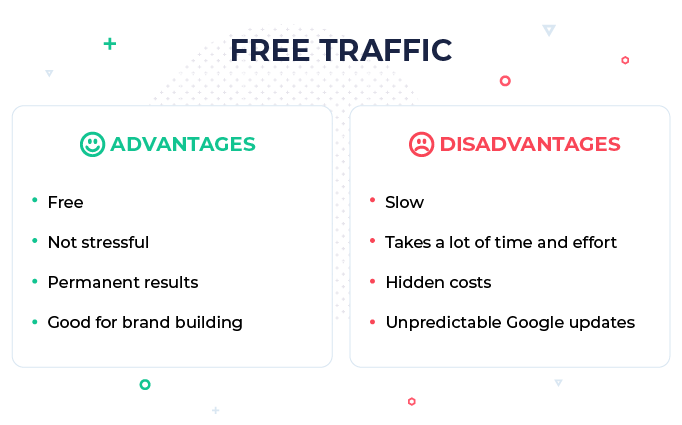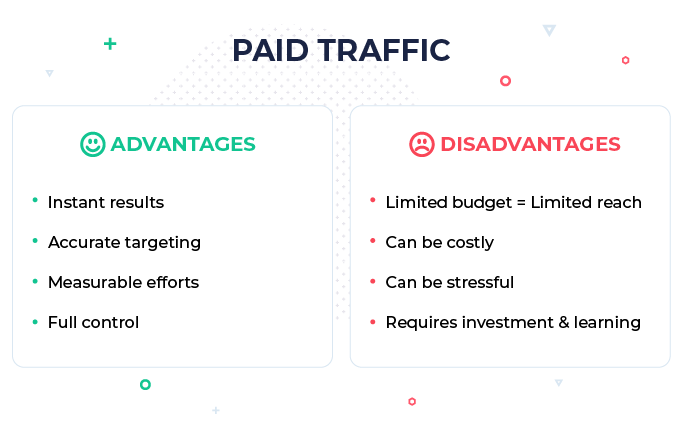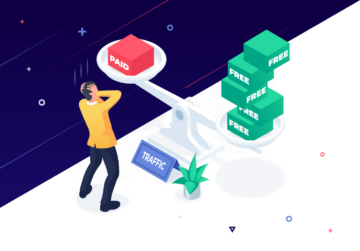In most cases, if you want to make money online, you need a website or a landing page. Whether you’re advertising a product, a whole store, or just a service, you need to drive traffic to your product’s page. Regardless of what your business offers, you need to somehow bring your products and the potential target audience together.
There are many different ways of advertising a product or a service via a website. However, they all come from either paid or free traffic sources.
Read the article and learn everything there is to know about free and paid advertising methods and how to use them to advertise your business effectively.
What is free traffic in digital marketing?
Free traffic means basically spreading the news and attracting people to your website in any way that doesn’t require payments or investing.
When you have a restaurant and want to advertise it for free, you can stand outside and hand out leaflets, just like the affiliate expert Charles Ngo explains. That’s more difficult when you have a website but still, just letting people know about what you do and how they can benefit from your products and services is the premise of free advertising.
For example, users can find their way to your website organically by entering the URL or searching for matching keywords in their browsers. They can also be advised to visit your page by another website, social media profiles or newsletters, and emails.
Examples of free traffic
Free traffic can be generated through all kinds of different sources, but they can all be categorized into either content marketing or SEO marketing (otherwise known as organic traffic).
Content marketing is basically about creating enough educational or interesting content to make people engage with your website and ultimately convert. Whether you’re trying to sell a physical product or have users download an app, the more people know and talk about your thing, the higher are the chances of conversions.
There are plenty of ways to inform your target audience that you have something to offer.
Here are the most common ways of obtaining free traffic:
- Email — if you’ve gathered an email database with the addresses of people you intend to target, you can send them messages advertising your products.
- Infographics — you can create informative content and share it on your website/channel.
- Social networks — follow for a follow and like for a like — you can make yourself known by creating social media profiles and then interacting with people and encouraging them to check out your affiliate website.
- Webinars — you can make a whole webinar about your product or the benefits of what you’re advertising.
- Word of mouth — you can tell your friends and family about what you’re advertising and ask them to spread the word.
- Podcasting — you can create a podcast about or related to the topic of your website.
- Direct/Referral links — you can talk to other website owners offering similar products and ask if they can mention you somewhere on their website.
- Forums — you can become active on Internet forums related to the subject of your website and you can promote your stuff there.
- Online videos — you can make videos with catchy titles that will recommend or link directly to your website.
- Comment marketing — you can surf the web and find relevant discussions and if anybody is looking for something like what you’ve got to offer — just drop these recommendations!
- Blogging — you can start a blog to promote your website or a product.
- News, media — if you are innovative enough to get yourself free media coverage, then it’s surely gonna bring you a load of conversions.
There is also another way of promoting your products and although it might sound simple and very efficient, it’s a lot of hard work.
SEO (Search Engine Optimization) means optimizing your content to rank on one of the world’s most popular search engines, Google. If your website appears high on the related Google search results page, it will get a lot of visitors who look for things related to the content of your website. Sounds simple and efficient, right?
But it’s not as easy as it seems.
In order to rank high on Google, your website needs to earn Google’s trust. There are many ways of doing that:
- The content needs to be properly optimized (keyword density, meta-tags, sentence length, or readability).
- You need to have links from other trusted sources pointing to your website.
- There should also be links leading to trusted websites.
- You need to create content that matches what users are most likely to look for.
- Your URL, meta-title, and meta-descriptions need to be properly optimized.
- You most likely need to use tools such as SEO Yoast or ahrefs (that aren’t free).
Once you have a site with good, SEO-optimized, content and many links are pointing to your website, you will most likely start receiving enough visitors to score conversions.
Advantage and disadvantages of free traffic
Free traffic is an attractive option for gathering leads because:
- It’s free, so you don’t need to set aside a significant portion of your budget for marketing.
- It’s time-consuming but not stressful, you just need a good strategy for building connections.
- The results are permanent, meaning that once you build a brand and connection you can expect the effects to last for a very long time, even after you cut down on the efforts.
- Content marketing is perfect for building your brand and staying in the memory of potential customers.
There are also certain aspects of free traffic that might prove to be a disadvantage, such as:
- The process is very slow, so it might take months or even years for your website to take off.
- It takes a lot of time and effort to build an SEO reputation.
- The tools cost money so that method might not be entirely free.
- Google updates and algorithm changes might destroy your entire SEO progress.

What is paid traffic?
Paid traffic, in simplest terms, is when you pay to display ads of your products. You can pay an agency, or you can become an affiliate advertiser yourself. You choose when and where to display an ad anywhere on the web. There are three models of payment:
CPC (Cost per Click) — you pay every time someone clicks on your ad. Let’s imagine you pay $0.03 for each visit and the product you sell on your website each costs $5. If 60 people choose to visit your website, you will pay $1.8 for advertising. If 10 users each buy your product, that’s $50 earnings. Now, if you subtract the cost of advertising from your earnings, that’s still $48.20 in profits.
CPM (Cost per Mille) — you pay for every 1000 views your ad gets. So if your ad gets shown 2000 times, and your CPM was set to $1, you will pay $2. This payout model is used, among others, for pop traffic.
Let’s imagine that for those 2000 impressions, you gather 60 users who become intrigued with your service. The ratio of impressions to page visits might seem small, but in reality, the impressions are very cheap and come in many forms. Sometimes more and sometimes less visible to an average viewer. Then, 10 users decide to buy the product, each product costing $5. Now, you’ve got $2 ad spend, and $50 profits, which gives you a pure profit of $48.
Flat Rate — that’s when you decide to purchase an ad spot for a set price and for a set amount of time. If your ad spot costs $50 per day, and you ‘rent’ it for 7 days, then it will cost you $350. One day you might score 5 sales, $5 each which won’t cover the price for the ad spot… but the next day you might get 30 ($300) sales which will make up for any previous losses.
If you are want to learn more about the different types of performance marketing pricing models then click here.
Examples of paid traffic
There are three ways in which you can advertise your business using paid traffic:
- Google Ads (Adwords) — you can create an account and pay to display your ads on the top of the search results list, so if a user enters a keyword related to your website, Google will suggest your website.
- Ad Exchange platforms — you can sign up to an ad exchange platform, such as Zeropark, and display your ads in the form of pop-ups, banners, or native ads (which are ads ‘pretending’ to be a part of a website).
- Social media advertising — you can pay to display your ads on platforms such as Instagram, Facebook (via Facebook Ads Manager), or TikTok so that when a user clicks on your ad they will be redirected to your website/landing page.
These are just some of the best paid traffic sources available, but you need to do your research to find which one is right for you and your paid advertising strategy. That’s why it’s a good idea to take a look at the pros and cons of paid traffic sources.
Advantages and disadvantages of paid traffic
Paid traffic can be a good way of advertising your products because:
- The results are instant as people start to see your paid ads as soon as you launch your campaigns (conversions might start flowing in immediately).
- The targeting can be adjusted to suit your needs, meaning that you can either target a broad audience at once, or only specific demographics (in the case of social media platforms).
- Your advertising efforts can be measured via various tracking tools (you know exactly how much you spend on what kind of content and how much profit it brings).
- You’re completely in control of how, when, what, and where you advertise.
But there are, of course, certain disadvantages:
- Your reach is limited to your budget — if you only have $20 a day for advertising, you will only be able to display your ads to as big of an audience as the $20 can buy.
- It can be costly for beginners as finding the correct targeting takes time.
- Managing many advertising campaigns can be stressful.
- It requires investment and learning the general procedures of affiliate marketing.

Conclusions
Both free and paid forms of advertising have their advantages and disadvantages. And both paid and organic traffic can help you scale your affiliate marketing campaigns.
If you are a content creator and your product fits in a complicated and interesting niche that you are very knowledgeable about, you can safely go for free traffic while enjoying the process of slowly building a brand or a business. But if you are focused on taking action and want to see the results as soon as possible, paid traffic is the way to go. You never know, you could be just about to reach a paid advertising gold mine.
So, think about what kind of business you are going to run and choose the best affiliate marketing traffic sources for your needs.
Do you feel that paid traffic is the way to go?
Try Zeropark now!
Magdalena Bober


